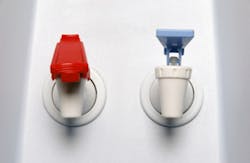Point of dispense UV disinfection removes waterborne microbial risks
In a September article in Water Technology, Lisa VanWyngarden of Waterlogic details how reverse osmosis (RO) water filtration can reduce the dissolved contaminants in water, yielding more pure and healthy drinking water. However, in some applications, a combination of treatment types is preferred.
While drinking water in the U.S. is far better than in many countries, municipal facilities’ systems are vast and aging with many potential contamination points. Faucets are increasingly cited as a source of pseudomonas and Legionella. Filtering and purifying water at the point of use (POU) provides many advantages, including the following:
- Cost savings
- Ease of use
- Strong environmental benefits when compared to a traditional bottled water cooler
While most RO systems are effective at removing some of the worst water contaminants, other points of possible contamination following RO filtration continue all the way to the faucet. End users need a solution at this location for a final barrier.
UV disinfection
Recent technology provides a solution right at the point of dispense and is 99.9999 percent effective against microbes 100 percent of the time, according to independent laboratory tests. It treats water with ultraviolet (UV) purification milliseconds before it exits the tap into a container and stops back contamination from outside the tap. While UV systems are not new, recent breakthroughs have allowed the UV to be positioned directly at the faucet. The benefit of such an intense UV at the faucet is not only the water purification but also in the ability to sanitize the faucet. If the faucet becomes contaminated by the end user (for example, from dirty hands, which probably cause the most outside contamination), UV technology also purifies the nozzle to 99.9999 percent.
A combination of RO, UV sanitization and antimicrobial materials of construction serve as a final barrier. Systems, at a minimum, should be certified by the Water Quality Association to American National Standards Institute (ANSI)/NSF 55a for UV treatment. To learn more, read the entire article here.
